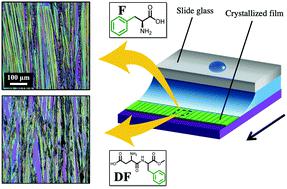当前位置:
X-MOL 学术
›
J. Mater. Chem. C
›
论文详情
Our official English website, www.x-mol.net, welcomes your
feedback! (Note: you will need to create a separate account there.)
Oriented crystal growth of phenylalanine and a dipeptide by solution shearing
Journal of Materials Chemistry C ( IF 5.7 ) Pub Date : 2020-05-15 , DOI: 10.1039/d0tc01208d Kazunori Motai 1, 2, 3, 4, 5 , Takuma Narimatsu 1, 2, 3, 4, 5 , Chen Chen 1, 2, 3, 4, 5 , Yuhei Hayamizu 1, 2, 3, 4, 5
Journal of Materials Chemistry C ( IF 5.7 ) Pub Date : 2020-05-15 , DOI: 10.1039/d0tc01208d Kazunori Motai 1, 2, 3, 4, 5 , Takuma Narimatsu 1, 2, 3, 4, 5 , Chen Chen 1, 2, 3, 4, 5 , Yuhei Hayamizu 1, 2, 3, 4, 5
Affiliation

|
Self-assembled structures of peptides have been recently gaining fundamental interest due to their unique electrical and optical properties arising from the variety of nanostructures. One of the challenges in this field is the formation of oriented nanostructures on a substrate. For more practical electrical applications, it is crucial to form their thin film on a substrate without losing their intrinsic physical properties due to random orientation. Here, we have developed a technique to form thin films of crystalized amino acids and dipeptides by solution shearing. We have characterized the thin films using polarized Raman spectroscopy and X-ray diffraction (XRD) measurements. Raman spectra revealed that the solution shearing allows us to form crystalline amino acids and dipeptides on Si wafers through control of crystal orientation along the direction of shearing. The XRD spectra supported the results of Raman spectroscopy, and also revealed the preferred orientation of the crystals in the out-of-plane direction. Futhermore, their polymorph formation was found to be suppressed by the solution shearing. This new approach to the formation of an aligned biomolecular thin film can be helpful for its bioelectronic applications in the future.
中文翻译:

溶液剪切法定向苯丙氨酸和二肽的晶体生长
肽的自组装结构由于其因各种纳米结构而产生的独特的电学和光学性质,最近已引起人们的广泛关注。该领域的挑战之一是在基底上形成取向的纳米结构。对于更实际的电气应用,至关重要的是在基板上形成其薄膜而不会由于随机取向而失去其固有的物理性能。在这里,我们开发了一种通过溶液剪切形成结晶的氨基酸和二肽薄膜的技术。我们使用偏振拉曼光谱和X射线衍射(XRD)测量来表征薄膜。拉曼光谱表明,溶液剪切允许我们通过控制沿剪切方向的晶体取向在硅片上形成结晶氨基酸和二肽。XRD光谱支持拉曼光谱的结果,并且还揭示了晶体在面外方向上的优选取向。此外,发现它们的多晶型物形成被溶液剪切抑制。这种形成取向的生物分子薄膜的新方法可能对将来的生物电子应用有所帮助。
更新日期:2020-07-02
中文翻译:

溶液剪切法定向苯丙氨酸和二肽的晶体生长
肽的自组装结构由于其因各种纳米结构而产生的独特的电学和光学性质,最近已引起人们的广泛关注。该领域的挑战之一是在基底上形成取向的纳米结构。对于更实际的电气应用,至关重要的是在基板上形成其薄膜而不会由于随机取向而失去其固有的物理性能。在这里,我们开发了一种通过溶液剪切形成结晶的氨基酸和二肽薄膜的技术。我们使用偏振拉曼光谱和X射线衍射(XRD)测量来表征薄膜。拉曼光谱表明,溶液剪切允许我们通过控制沿剪切方向的晶体取向在硅片上形成结晶氨基酸和二肽。XRD光谱支持拉曼光谱的结果,并且还揭示了晶体在面外方向上的优选取向。此外,发现它们的多晶型物形成被溶液剪切抑制。这种形成取向的生物分子薄膜的新方法可能对将来的生物电子应用有所帮助。

































 京公网安备 11010802027423号
京公网安备 11010802027423号